Sterling Beer: Circa 1948-1950
This month is an old favorite, a Sterling Beer from Sterling Brewing in Evansville, Indiana.
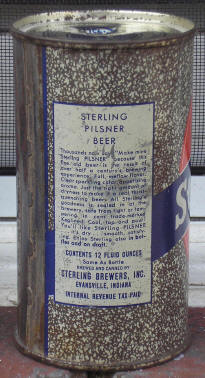 |
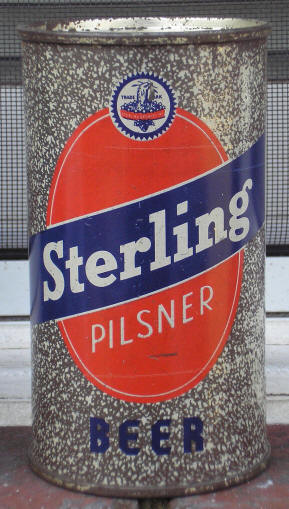 |
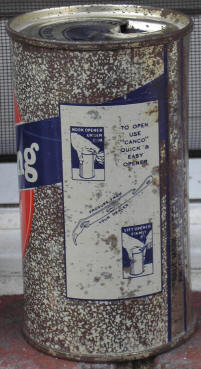 |
I used to dump these cans on a cousin's land in Taylor County, Kentucky as a kid in the 1970s, and then in Jefferson County, Indiana along the Ohio River as a college student. As a result, they've always been a favorite.
Sterling Brewing 1863-1964
Sterling Brewing started in 1863 as one of several small breweries in a river town busy with traffic during the Civil War. It was started by Henry Schneider but went through numerous ownership changes over the next 14 years. In 1869 and 1876 the local sheriff sold the brewery to satisfy financial obligations of a bankrupt brewery. Initially it was a small "cave brewery" but in 1877 John Hartmetz moved to Evansville from Louisville, where he had owned part of what would become the Oertels Brewery. Hartmetz bought the struggling business and it finally began to do well.
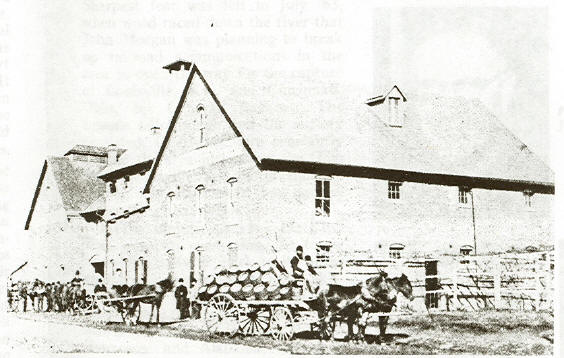
Hartmetz Brewery (date unknown)
John Hartmetz had several sons, the oldest of which was Charles. In 1894 John took most of his family to Europe, leaving Charles to run the brewery. When the family returned they found that the brewery was now named John Hartmetz and Son. Charles was eventually joined by the youngest son, Otto Hartmetz, who became a master brewer and worked with the brewery until he retired in 1956. He remained on the board of directors as did Charles.
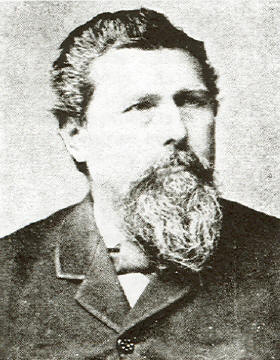 John Hartmetz
John Hartmetz
In the 1890s there was a price war among breweries throughout the US as modern production outpaced demand. In Evansville the price war centered on the F.W. Cook brewery, owned by a large English syndicate, and the rest of Evansville's breweries not in the syndicate. (See my Frank Jones page for more details about the influx of British investors in the US brewing industry at this time). In response to F.W. Cook, three of Evansville's breweries, John Hartmetz and Son, Evansville Brewery, and the Fulton Avenue Brewery, joined to become the Evansville Brewing Association in March 1894. Both Charles and John Hartmetz were on the five member board of directors. The Fulton Avenue facility became the company headquarters apparently because it was the most modern of the three. In October 1880, only a year after Edison introduced his incandescent light bulb, the Fulton Brewery had them installed. Three lights were installed in the brewery, and three in the cellars. (At the time, of course, six of the new electric lights would have been considered quite the show!) After Prohibition the Fulton Avenue brewery would become the Sterling Brewery, but with the Hartmetz family in control.
The Dry Years
Prohibition came to Indiana the same way it did in many other states, through local option, then state-wide even before the 18th Amendment went into effect in 1920. While the Evansville Brewing Association and F.W. Cook were rivals in selling beer, they united against the growing strength of the dry's in trying to convince Indiana voters that Prohibition was a mistake. In 1917, Charles Hartmetz, now President of the company, warned that if Indiana went "bone dry" it would close 3,500 saloons, each of which made an average of $1,000 a month. Prohibition would remove 42 million dollars in liquor business (not just beer). The dry's argued that this money was better spent elsewhere than in saloons. The Wright Act, signed in early 1917, made Indiana officially "dry" as of April 1918. Both F.W. Cook Brewing and the Evansville Brewing Association filed suit in the State Supreme Court to have the law over-turned. The Court refused.
Anticipating the worst, in 1917 the board of the Evansville Brewing Association voted to create two new companies, the Sterling Products Company and the Sterling Refining Company. The Sterling Products Company was designed to make cider as well as to can fruit, syrups, etc. In the end, they ended up selling a great deal of malt syrup for "home baking."
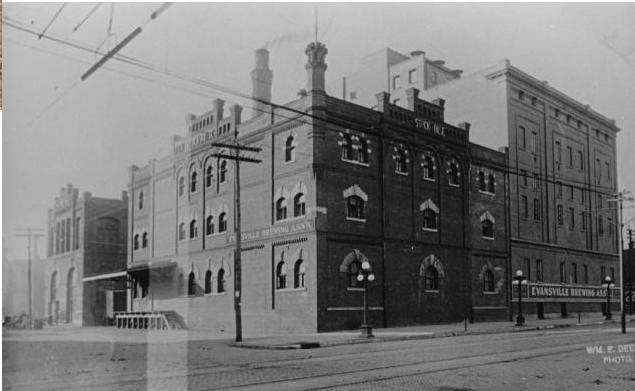 |
Evansville Brewing. Photo courtesy of the Willard Library.
Post-Prohibition
When Prohibition was nearing its end in the early 1930s the management of Sterling Products decided to change the company to Sterling Brewing and prepared to start brewing beer again. They remodeled at least some of the brewery including the cellars in early 1933. They replaced old wooden tanks and the wood fermenters with new steel ones. Soon after Prohibition ended, Sterling was back up and running, as were their old rivals, the F.W. Cook Brewing Company.
The brewery was doing well. In July 1937 Sterling added a second facility in Freeport, Indiana to increase production. This second plant added 50,000 barrels a year to the Evansville production of 500,000. The Freeport facility operated from 1937-1939. Charles Hartmetz died in 1939, leaving younger brother Otto Hartmetz as the remaining Hartmetz in the brewery's management.
Sterling was sold in the midwest and throughout the south. They began canning beer in early 1938. Sterling canned both their Sterling Beer and Sterling Ale, although the ale cans are much less common than the beer cans. Sterling was one of only a small handful of brewers that continued to feature opening instructions on their cans past 1950.
 |
 |
Two 1939 Sterling Beer ads.
Sterling seems to have been a big seller in its region through the 1950s, at least judging from the cans left behind in dumps in the states around southern Indiana. The can featured at the top of this page has a Kentucky tax stamp and is common enough that I picked it up for less than $20.00, even though it's in great condition. In 1963 the company celebrated its 100 anniversary. However, only the next year it was sold to Associated Brewing. G. Heileman Brewing bought the brewery in 1972 and continued to produce the beer, but for the low-price market. (I remember trying it in college in the late 1970s and it wasn't very good). Heileman pulled out in 1988 and the Evansville Brewing Company was formed to take over the old brewery. They closed in 1997.
Sterling TV Advertisements and The Chad Mitchell Trio
Answer: Yes they did. I heard from Tom in Williamsburg that he also remembers the Chad Mitchell Trio doing Sterling ads. Thanks Tom! A Brewer's Digest story from July 1963 also noted that the brewery had used the Chad Mitchell Trio "effectively in their advertising" and that they would appear "in a personal appearance at the Amphitheater in Evanston." |
Sterling "Mug" Bottles
In 1963 Sterling introduced a new wide-mouth bottle with an easy open top. The consumer didn't need a churchkey to open these bottles as they had a tear-away lid. They were also disposable so they could compete with the new zip-top cans that also didn't need an opener. Several other companies used the bottles, including Rheingold in New York.
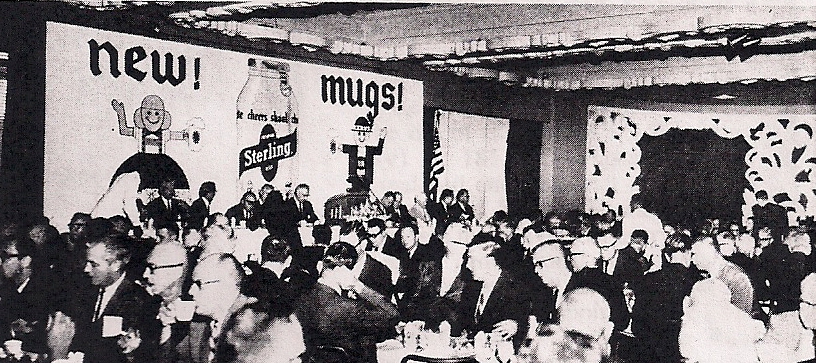 |
The new bottles were promoted in August 1963 at a distributors' luncheon held at the brewery's rathskeller. |
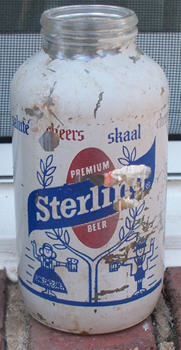 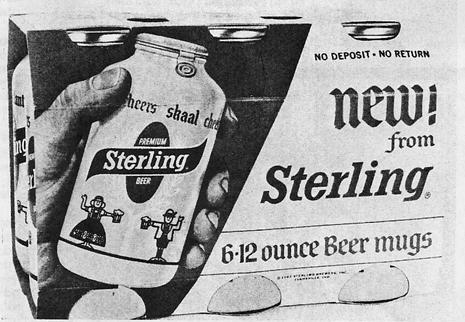 |
An advertisement promoting the new bottles from around June 1963 |
Name Changes
Henry Schneider 1863-?
Koeth & Co. c. 1875
John Hartmetz (Vanderburg Brewery) 1877-1890 (Clark & Carpenter Streets)
John Hartmetz & Son 1890-1894
Evansville Brewing Association 1894-1895
(note, at this point the brewery moved to another facility also owned by the Evansville Brewing Association on Fulton Avenue)
Evansville Brewing Association 1895-1918 (Fulton Avenue)
Sterling Products Association 1918-1933
Sterling Brewers, Inc. 1933-1964
Sterling Brewers Association (br. of Associated Brewing Co., Detroit, MI) 1964-1968
Associated Brewing Co. 1968-1972
G. Heileman Brewing 1972-1988
Evansville Brewing Co. 1988-1997
Additions and corrections are always welcome! Please email me at Mark@rustycans.com
Sources Used:
Beer Can Collectors of America. United States Beer Cans (Beer Can Collectors of America: Fenton, Mo)
Lantzer, Jason S. "'Dark Beverage of Hell:'The Transformation of Hamilton County's Dry Crusade, 1876-1936" on www.connerprairie.org
"Sterling Beer is Rated Among Nation's Finest" Freeport Journal-Standard. April 28, 1938.
"Sterling Brewers, Inc., Evansville, Ind. Remodels Cellars at Low Cost" Western Brewer. October 1933.
"Temperance News" Indiana Weekly Messenger. April 5, 1917.
"The Sterling Story" Brewer's Digest. July, 1963.
Van Wieren, Dale P. American Breweries II (West Point, PA., East Coast Breweriana Association, 1995)
Willard Library, Evansville, Indiana.

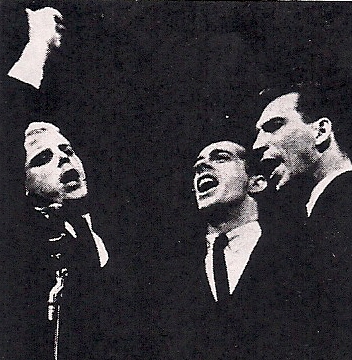 I received an email about Sterling's TV ads asking: Did the folk singing group The Chad Mitchell Trio do commercials for Sterling beer in the early 1960's? The commercials started out "We sing around here for Sterling beer..." Thanks!
I received an email about Sterling's TV ads asking: Did the folk singing group The Chad Mitchell Trio do commercials for Sterling beer in the early 1960's? The commercials started out "We sing around here for Sterling beer..." Thanks!